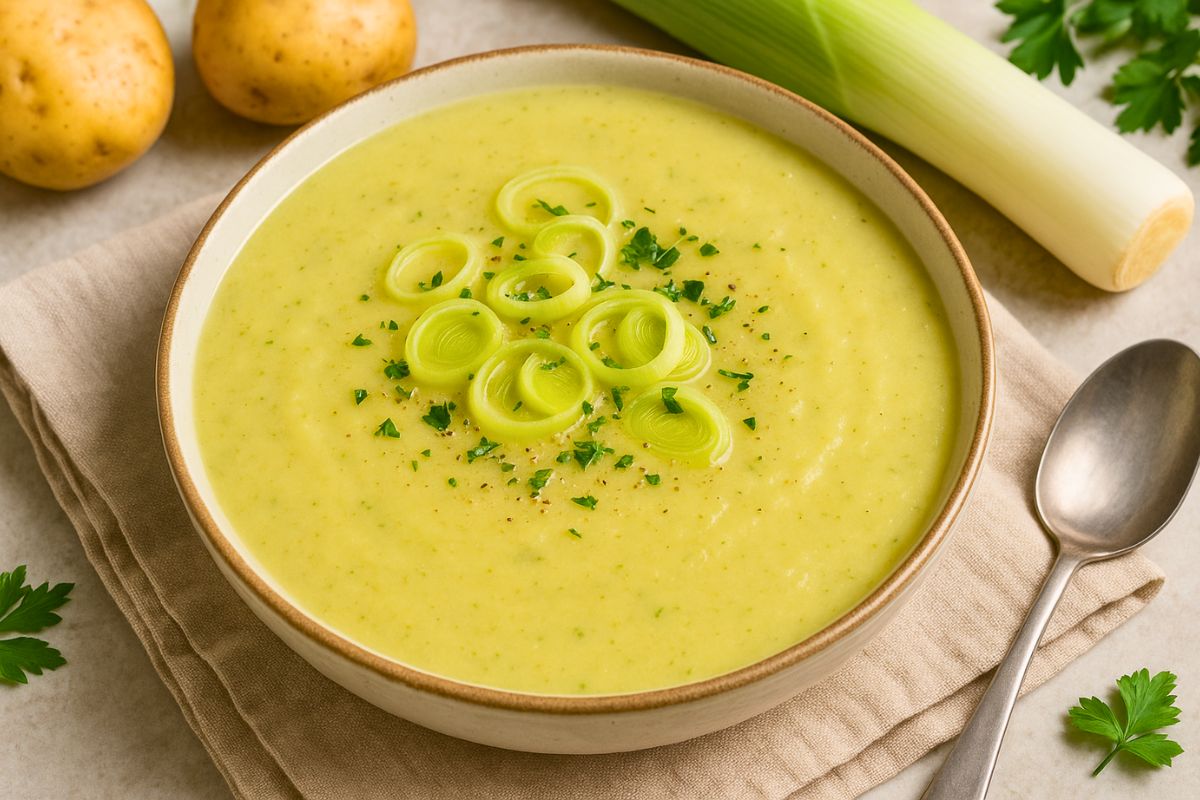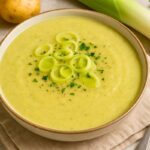Listen, I’m going to be straight with you. I’ve made Mary Berry’s leek and potato soup about 20 times now. Maybe more. Sometimes it’s been gorgeous. Other times a bit bland. Once it was downright gritty because I didn’t clean the leeks properly. But when you get it right? Lovely.
There are soup recipes everywhere. Loads of them. All decent. But Mary’s one is just so easy that even when I’m absolutely knackered after work, I can make it without thinking too much.
How To Actually Make Mary Berry Leek and Potato Soup
Right, here’s how you do it. I’m writing this like I’m telling my mate who’s never made soup in their life.
Step 1: Get Your Leeks Sorted
Grab three medium leeks. Chop the roots off. Chop off the really dark green tops too. Keep some of the lighter green bits, though. Cut them down the middle lengthwise. Then cut across into slices. Not too thick.
Chuck them in a bowl of cold water and swish them about. Lift them out. Look at the bottom of the bowl for grit. See muck? Wash them again. This bit’s boring but if you don’t do it, you’ll be eating grit later. Trust me.
Step 2: Chop Everything Else
Peel about four medium potatoes. Chop them up. Chunks about 2cm. A bit bigger, a bit smaller; it doesn’t matter really. Peel one onion. Chop it up. Not bothered about the size, to be honest.
Step 3: Start Cooking
Get a big pan. Chuck a good knob of butter in. About 50g if you’re being precise but I just hack a chunk off. Let it melt. Chuck the leeks and onion in. Stir them about so the butter coats everything.
Stick the lid on. Turn the heat right down. Here’s the bit that matters. Let them sit there for ten minutes. Give them a stir every so often. You want them soft and sweet. Not brown. Brown means you’ve had the heat too high.
Step 4: Add The Rest
When your leeks and onions are soft, chuck the potato chunks in. Pour in a litre of stock. Chicken stock tastes better, but vegetable stock works fine. Bring it up to a simmer. Then turn it down.
Let it bubble away gently for about 20 minutes. The potatoes need to be properly soft. Poke one with a knife. If the knife goes in easy, you’re sorted. If not, keep cooking.
Step 5: Blend It
Take the pan off the heat. Get your blender. Whizz it till it’s smooth. Got a jug blender? Let it cool for a few minutes first. Do it in batches. Hot soup exploding everywhere is not fun.
Ask me how I know. You can blend it however you like, really. I leave it a bit textured. Most people want it really smooth, though. Up to you.
Step 6: Season It
Taste it. Add salt and pepper. Taste again. Add more if you need to. This bit matters more than you think. Soup with no seasoning is just disappointing.
Step 7: Serve It Up
Ladle it into bowls. If you want to be a bit fancy, swirl in some cream or chuck some chopped parsley on top. Bacon bits are gorgeous too. Serve with crusty bread and butter.
That’s it. Dead simple, really.
Do You Actually Need Cream?
Mary’s original recipe has cream in it. Most do. But honestly? Leek and potato soup without cream is just as good if you do everything else right. The potatoes make it creamy anyway when you blend them.
I’ve made it both ways. With cream, it’s richer and feels more special. Without cream, it’s lighter and you can eat more without feeling stuffed. Depends on what you fancy, really.
If I’m making it for people, I sometimes put a little jug of cream on the table so they can add their own. Or crème fraîche. Or nothing. Whatever they want. Takes the pressure off.
Getting The Best Leek And Potato Soup
The best leek and potato soup comes down to a few things.
- First, don’t use ancient potatoes that have been in your cupboard since last Christmas. Fresh potatoes that aren’t sprouting weird things work better.
- Cut them into similar-sized pieces. I go for chunks about the size of a Malteser. Maybe a bit bigger. They won’t cook evenly if some are massive and others tiny. You’ll end up with lumpy soup.
- Let them simmer for twenty minutes. Poke a knife in a potato chunk. If it goes in easily, you’re sorted. Keep cooking if there’s any resistance.
You can’t blend hard potatoes. Well, you can try, but your blender will make horrible grinding noises and you’ll get lumps everywhere.
Salt Is More Important Than You Think
This is where loads of people mess up. Different stocks have completely different salt levels. Some supermarket stocks are salty as hell. Others have barely any. If you made your own stock, who knows how much salt is in there?
Always taste before adding salt. Then add a bit. Taste again. Add more if you need it. I’ve oversalted soup before and there’s not much you can do except make another batch or chuck loads of potato in to dilute it.
Black pepper is good too. Not loads. Just enough to give it a bit of warmth. Makes it more interesting.
ALSO READ: Ray Kroc Net Worth and Former CEO Legacy Behind McDonald’s
What I Do Differently Now
After making Mary Berry’s leek and potato soup loads of times, I’ve started changing bits. Sometimes I’ll fry some bacon till it’s crispy, chop it up, and scatter it on top. Gorgeous.
- Fresh parsley is nice if you’ve got some knocking about. Chives work too. Just chop them up and sprinkle them on at the end. Makes it look prettier and adds a fresh taste.
- A bit of garlic doesn’t hurt either. I’ll chuck in a couple of crushed cloves with the leeks sometimes. Not essential but I like garlic.
- Some people blend it till it’s completely smooth. I quite like leaving it a tiny bit chunky. You get some texture but it’s not lumpy. Up to you, really.
Final Thoughts
I keep making this soup because it’s reliable. It tastes like leeks and potatoes, not just salt and cream. It’s filling without being heavy. It’s cheap to make. And when the weather’s cold and you just want something warm, it does the job.
That’s all you can ask of a soup recipe, really, isn’t it? Something that tastes good, doesn’t cost a fortune, and doesn’t take all bloody night to make. Mary’s recipe does all three. That’s why I keep coming back to it.








